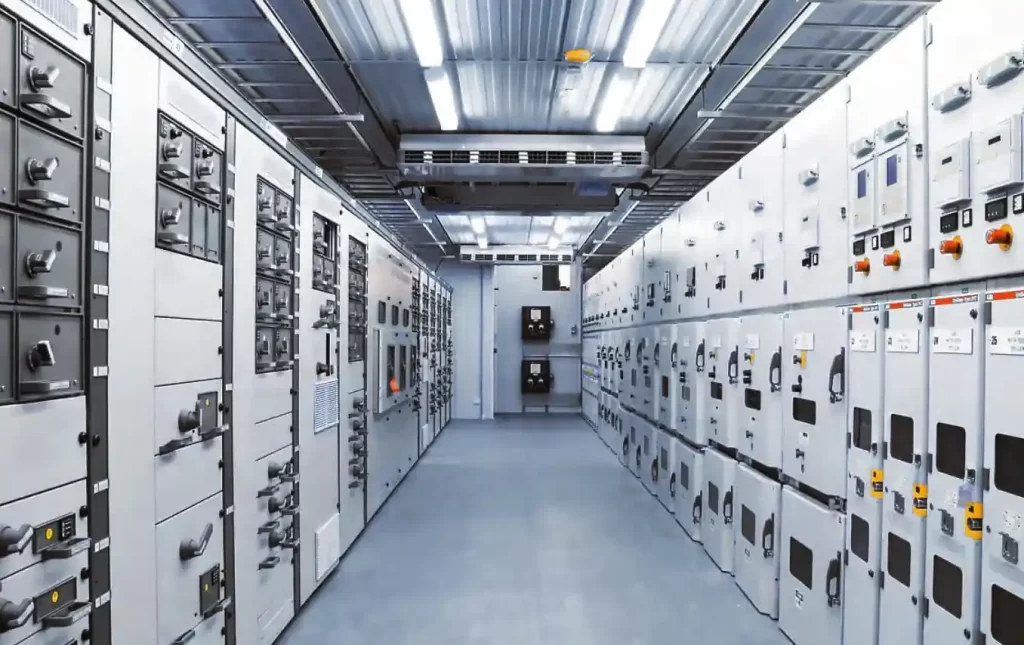
1. Core Concepts: What is Gas-Insulated Switchgear?
Gas-insulated switchgear (GIS) is a compact, high-voltage electrical substation technology that uses sulfur hexafluoride (SF6) or eco-friendly alternatives as an insulating medium. Unlike air-insulated switchgear (AIS), GIS encloses critical components in sealed metal chambers filled with pressurized gas, enabling space savings of 50–70% while enhancing reliability in harsh environments.
Key Components:
- Circuit breakers: Interrupt fault currents using SF6 gas quenching.
- Disconnectors/earthing switches: Isolate sections for maintenance.
- Busbars: Conduct current within gas-insulated tubes.
- Surge arrestors: Protect against voltage spikes.
- Gas monitoring systems: Track SF6 pressure and purity (critical for IEEE C37.122 compliance).
2. Applications: Where GIS Excels
GIS is widely adopted in environments where space, safety, or climate resilience are priorities:
- Urban power grids: Substations in cities like Tokyo and New York rely on GIS to minimize footprint (ABB, 2023).
- Industrial plants: Oil refineries and data centers use GIS for dust- and corrosion-resistant operation.
- Renewable energy: Offshore wind farms leverage GIS’s compact design for platform-based substations (Schneider Electric, 2022).
- High-altitude regions: SF6’s stable insulation properties outperform air at low pressures (IEEE Transactions, 2021).
3. Market Trends & Drivers
The global GIS market is projected to grow at 6.8% CAGR (2023–2030), driven by urbanization and grid modernization (Grand View Research). Key trends:
- SF6 phase-out: EU F-gas regulations and IEEE standards promote SF6-free GIS using mixtures like Clean Air (ABB) or g³ gas (GE).
- Digital integration: IoT-enabled GIS with real-time gas leakage detection and predictive maintenance (Siemens, 2023).
- Renewable integration: 72% of new solar/wind projects in Asia-Pacific specify GIS for grid connection (Mordor Intelligence).
4. Technical Comparison: GIS vs. AIS
| Parameter | GIS | AIS |
|---|---|---|
| Footprint | 10–30% of AIS | Large outdoor space needed |
| Wartung | 20–40% lower lifecycle cost | Frequent cleaning required |
| Voltage range | 72.5 kV – 1,100 kV | Up to 800 kV |
| Environmental risk | SF6 handling protocols | Minimal gas dependency |
Source: IEEE Standard C37.122-2021
5. Why Choose GIS Over Alternatives?
GIS outperforms AIS and hybrid systems in:
- Space-constrained sites: Ideal for skyscraper basements or mountainous terrain.
- Extreme weather: Sealed design resists salt spray, sandstorms, and humidity (IEEMA, 2022).
- Langlebigkeit: 40+ year operational lifespan with proper maintenance (Schneider Electric case studies).
6. Purchasing Guidance
Consider these factors:
- Voltage class: 145 kV systems dominate urban grids; 420 kV+ suits transmission hubs.
- Gas type: Opt for SF6-free GIS if operating in regulated regions (EU, California).
- Modularity: Prefabricated GIS modules reduce on-site assembly time by 60% (Hitachi Energy).
- Certifications: Ensure compliance with IEC 62271-203 or local grid codes.
Pro Tip: Partner with vendors offering lifecycle services, like Mitsubishi’s GIS Health Check, to optimize ROI.
7. FAQs
A: SF6 gas quality checks every 3–5 years; mechanical inspections every 8–10 years (IEEE C37.122).
A: Modern GIS recovers >99% of SF6 via closed-loop systems, and alternatives like GE’s g³ gas reduce GWP by 99% (GE Grid Solutions).
A: Yes—modular designs allow phased upgrades without full shutdowns (Siemens, 2023).
8. Authority-Backed Insights
- IEEE Power & Energy Society: Recommends GIS for urban resilience.
- ABB White Paper: Highlights 30% energy loss reduction using GIS in distribution networks.
- Wikipedia: GIS adoption rates exceed 80% in Japan and Singapore.
With its unmatched efficiency and adaptability, GIS remains pivotal in building future-ready grids. Whether upgrading a downtown substation or connecting a wind farm, GIS balances innovation with operational pragmatism.
Keywords naturally integrated: gas-insulated switchgear, GIS components, SF6-free GIS, high-voltage transmission, IEEE C37.122
Get a printable version of this page as a PDF.